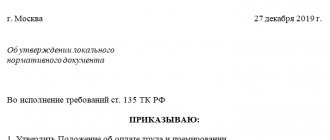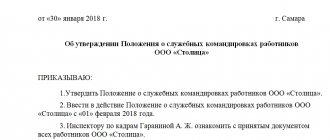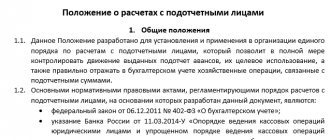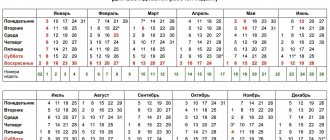Is it possible not to draw up a wage regulation and can they be punished for this?
The wage regulations are one of the employer’s internal documents.
It is necessary not only to describe the applied system of calculation and remuneration for labor, but also to consolidate the system of material incentives and rewards for employees in the organization. This provision justifies the legality of including salary costs in tax expenses. Its absence sharply reduces the chances of proving to tax authorities the legality of reducing the tax base for income tax or the simplified tax system for bonuses, additional payments, compensation and other similar payments.
Find out whether the employer is obliged to pay a bonus by following the link.
Given these advantages of the provision, taxpayers in most cases spare no time and effort in developing it.
You can do without such a document only in one case - if all the terms of remuneration are described in employment contracts with employees or in a collective agreement, or all employees of the company work under conditions that exclude any deviations from the usual (do not work overtime, at night and on holidays ). In this case, there is no need to draw up a separate provision.
The legislation of our country does not contain an unconditional requirement to develop and apply wage regulations for each employer. There are no requirements for the form, type and content of this document. Therefore, there will be no punishment for the arbitrary form of the provision or its absence as a separate document.
And if changes are made to working conditions, disputes may arise with both employees and workers. Find out how to correctly approve the wage regulations and avoid claims from a consultation with an expert from the Ministry of Labor. To do this, go through a quick registration in the ConsultantPlus system and get trial access for free.
Regulations on remuneration and bonuses for employees: is it necessary to combine
Since there are no legal requirements on this issue, in different companies you can find a variety of options for drawing up internal documents related to the calculation and payment of wages to employees.
For example, the regulations on wages are drawn up as a separate document, and the conditions for bonuses are prescribed in another local act - the regulations on bonuses and material incentives for employees. It is possible to provide for other salary provisions: on wage indexing, summarized recording of working hours, etc.
Some employers are limited to approving only one document - a collective agreement, which stipulates all the necessary aspects of the salary policy.
Read about the purpose and features of a collective agreement in the material “Collective agreement as a form of social partnership.”
The decision on whether to prescribe all the necessary salary nuances in one document or formalize each significant issue in separate provisions remains with the management of the company or the employer-individual entrepreneur. If a decision is made to combine the issues of the payment system and the features of bonuses in a single provision, it is necessary to spell out all the nuances in this document as scrupulously as possible.
To learn about what bonuses and rewards can be for employees, read the article “What are the types of bonuses and rewards for employees?” .
Main sections of the regulations on remuneration and bonuses for employees
The regulations on wages and bonuses for employees may include, for example, the following sections:
- general terms and definitions;
- description of the current form and wage system in the company;
- terms and forms of salary payment;
- employer's liability for delayed wages;
- duration of the provision;
- “Additional payments” table;
- “Compensation” table;
- table "Allowances";
- “Premiums” table;
- table “Other employee benefits”.
The general section provides a link to the regulatory documents in accordance with which this provision was developed. Then a decoding of the basic concepts and terms used in the provision is given, so that any employee, when reading it, would not have difficulty understanding the contents of the document. The same section indicates who this provision applies to (employees under an employment contract, part-time workers, etc.).
The second section is devoted to a description of the wage system (WRS) adopted by the employer (time-based, piece-rate, etc.). If different SOTs are provided for different categories of workers and employees, a description of all applicable systems is given.
The section intended to describe the terms and forms of salary payment indicates the dates for the payment to employees of their earned remuneration (advance payment and final payment). You cannot limit yourself to a one-time payment of salary income.
See also “Advance payment – what percentage of salary?” .
IMPORTANT! Remuneration for labor must be paid at least 2 times a month (Part 6 of Article 136 of the Labor Code of the Russian Federation, letter of Rostrud dated May 30, 2012 No. PG/4067-6-1). Violators of this requirement may face administrative liability under clause 6 of Art. 5.27 of the Code of Administrative Offenses of the Russian Federation (fine from 30,000 to 50,000 rubles for a company, from 10,000 to 20,000 rubles for its officials and from 1,000 to 5,000 rubles for individual entrepreneurs). Also keep in mind that the payment period must be determined by a specific date; you cannot create a “fork” of dates.
However, paying wages more than 2 times a month will not violate any norms. Read more about this in the material “Salaries can be paid more than twice a month .
The same section reveals the form of remuneration: in cash through a cash register or by transfer to employees’ bank cards, as well as the percentage of possible payment of part of salary income in kind.
A separate paragraph reflects information related to the employer’s responsibility for delayed wages.
IMPORTANT! The employer's financial liability for delayed wages is provided for in Art. 236 of the Labor Code of the Russian Federation, which sets the minimum interest rate (not lower than 1/150 of the refinancing rate of the Central Bank of the Russian Federation from amounts not paid on time for each day of delay).
The regulations may establish an increased amount of compensation.
The main text part of the provision ends with a final section, which indicates the period of its validity and other necessary conditions.
Legal requirements for document structure
The law does not establish unified requirements regarding the structure of the Regulations. The recommended structure of the Regulations includes several sections:
- General provisions
This section provides the terminology used in the Regulations and its interpretation. The general principles of operation of the Regulations are revealed. References are given to regulations governing labor legislation, on the basis of which the remuneration system established by the Regulations was developed. Other general issues are also discussed. - The procedure for remuneration and conditions for making payments
This section is the main one. In it, the employer describes the payment system for each category of its employees: the amounts of official salaries and tariff rates, as well as the grounds on which they can be revised. - payments, allowances and other compensation payments
The issue of additional payments is regulated in sufficient detail by the Labor Code, therefore, as a rule, drawing up this section does not cause any particular difficulties. It must contain information about the procedure in which additional and compensation payments are made, for example, night workers, part-time workers, etc. - Bonuses and incentive payments
The use of incentive payments depends on the financial situation of the company. The employer has every right to establish any policy for rewarding its employees. In particular, you can encourage employees to:- for skill and professionalism;
obtaining an academic degree;
- advanced training, etc.
- Responsibility of the employer
The Regulations should stipulate the responsibility of the employer in case of violation of laws relating to remuneration. In particular, it is possible to include in this section a rule establishing increased amounts of compensation for late payment of wages compared to the standards provided for by the Labor Code. - Final provisions
Bonuses can be either systematic or one-time. The award of the bonus depends on the employee’s performance.
In order to avoid future conflict situations that could lead to labor disputes, the possibility of assigning a bonus based on the subjective assessment of the manager should be excluded. Situations in which an employee is subject to bonuses, the size of bonuses, as well as their frequency should be specified in the local act of the enterprise.
When developing this section, attention should be paid to clarity and unambiguous wording in order to avoid conflict with employees.
The final section should contain information about the entry into force of the Regulations, the procedure for amending and supplementing it, the place where the document is stored, and information about the persons responsible for its storage. This section also includes questions that were not included in previous sections.
Important! The given list of sections of the Regulations may be supplemented and modified by the employer. For example, sections on financial assistance and salary indexation can be added.
Tabular part of the position
In the structure of the position from the example considered, all additional payments, compensations and bonuses are placed in separate tabular sections. This is not necessary - the text form of presentation can also be used. In this case, this method of structuring information was used for the purpose of clarity and ease of perception.
For information about what payments form the remuneration system, read the article “Art. 135 of the Labor Code of the Russian Federation: questions and answers" .
The “Additional payments” table contains a list of those salary supplements that are applied by the employer. For example, these could be additional payments related to overtime work, for night work or the employee’s work on a holiday, and other additional payments.
For each type of additional payment, the corresponding interest rates are indicated in the table. For example, for night work the surcharge is 40% of the hourly rate (for hourly workers). The necessary explanatory data is indicated in a separate column of the table (it may be called “Note”). For example, for additional payment for night work, this column shows the period considered night: from 22:00 to 6:00.
The structure of the “Compensation” table is similar to that described above. The listed compensations (for example, for harmful and dangerous working conditions, upon dismissal, reduction, etc.) are supplemented with the corresponding amount or calculation algorithm.
The “Additions” table is present in the regulations only if this type of monetary supplement to the employer’s salary exists. An example is the bonus for length of service. In this case, it is necessary to explain in detail for what period what amount of the premium is due. For example, for work experience from 4 to 7 years, the salary increase will be 12%, from 7 to 10 - 15%, and over 10 years - 18% of the accrued salary.
The remaining tables are filled in the same way.
You can see and download a sample regulation on remuneration and bonuses for employees - 2022 on our website using the link below:
How to enter a position
The development of local regulations is carried out by management. But the executive body alone does not have the right to adopt the Regulations on remuneration and bonuses for employees. In accordance with Article 135 of the Labor Code of the Russian Federation, any internal regulatory documentation affecting wages must receive the approval of a trade union (of course, if there is one at the enterprise)
IMPORTANT!
If there is no such body in the company, then there is no need to approve the Regulations on Payment.
When a compromise is reached, the leader issues an order. In it he reflects:
- the fact of approval of the document, its name may vary (about payment, about bonuses, about the motivation system, about rewards for work);
- the need to familiarize all employees with it (in accordance with Article 22 of the Labor Code of the Russian Federation);
- the obligation to familiarize newly hired employees with it before signing the contract (in accordance with Article 68 of the Labor Code of the Russian Federation);
- responsible;
- control over execution.
From the date specified in the order, the Wage Regulations come into force. It is signed either by the manager (for example, the general director) or by a person with the appropriate authority - by proxy. This means you should make sure that the latter is valid at the time of signing.
It is mandatory for all employees to familiarize themselves, against signature, with the Regulations on Remuneration, whether newly introduced or already existing at the enterprise. There are several ways to do this correctly:
- draw up a special familiarization sheet, under which all employees will sign;
- create a special journal to record the fact of familiarization with internal regulations and make appropriate entries with the signatures of employees in it;
- For newly hired employees, the fact of familiarization may be indicated in the employment contract.
Is it necessary to review the wage regulations every year?
The wage regulations can be approved by the employer once and be valid without a time limit (indefinitely). The legislation does not establish any specifics for the validity period of such a document.
The need for an annual review of the regulations may arise in cases where the employer is developing new types of activities involving workers of various professions, for which a revision or addition of existing SOT and incentive payments is necessary, or working conditions are changing.
The employer and employees are interested in keeping their internal local acts up to date and must promptly initiate their revision, including the provisions under consideration.
We will tell you what to indicate in the order approving the wage regulations here.
What should be the form and validity period of the document?
The regulation does not have a standard form, so each enterprise forms it independently, establishing and thinking through its own structure and remuneration algorithms - taking into account regional and industry specifics, but within the framework of federal legislative norms.
According to the general rules of labor relations, the Regulations from the moment of its publication at the enterprise become mandatory for execution by both the employer and employees.
The validity period of the Regulation is determined by the employer. As a rule, the document is valid indefinitely and is subject to adjustment in cases where:
- the enterprise plans to open new types of activities that will require the involvement of specialists from various professions;
- The terms of remuneration for existing employees of the company are changing.
Both employers and employees can initiate the maintenance of the current state of local acts.
The provision may exist in the form of an annex to the employment contract or adopted as an independent regulatory act.
What nuances are provided for in the provision for piecework wages?
Piece wages are one of the forms of remuneration in which the amount earned depends on the number of units of product produced by the employee or the amount of work performed. This takes into account the quality of the work performed, the complexity of execution and working conditions.
There are several types of piecework wages:
- simple;
- piecework-bonus;
- chord.
It is based on piece rates, and other salary supplements (for example, a bonus for absence of defects) are set as a fixed amount or as a percentage of the amount earned.
Depending on the types of piecework wages used, the regulations provide for the specifics of calculating and paying wages, taking into account all the nuances of a given SOT for a particular employer.
Read more about the piece-rate and bonus payment system in the material “The piece-rate and bonus payment system is...” .
Find out how an organization can switch to a new remuneration system in the ready-made solution ConsultantPlus.
What to include in the clause
Typically, the number of points depends on the number of remuneration systems used, additional payments and other specifics of a particular organization. Sometimes consideration of individual issues is included in separate sections (for example, “Payment systems” are considered not in the “General Provisions”, but separately from them, as a separate part), or are listed in the water part - this option illustrates a sample provision on remuneration and bonuses for employees .
The legislation does not contain a strict form for this case. Typically the document includes the following sections:
- General provisions. Here they indicate how remuneration occurs, salary calculation, how the amount is regulated, how the salary is determined, and what its amount depends on. Also in the General Provisions it is worth considering such important issues as working time standards, existing rates, payment currency, and deductions from payments.
- Additional payments. This section contains the procedure for assigning additional payments, their types, possible and maximum amounts.
- Bonuses for successful work and effective performance of duties. Here you should describe when and in what amount the manager undertakes to pay bonuses, the grounds for incentives, and the nuances for different categories of employees. If the enterprise has a separate document regulating bonus issues, it is enough to refer to it.
- Compensation.
- Allowances.
- Amount and cases of payment of financial assistance.
- The procedure for indexation or actual salary content, which, according to the Labor Code of the Russian Federation, is an obligation, and not a right, of the employer. Moreover, the development of a local regulatory act on the procedure for increasing the real content of earnings is mandatory, in accordance with judicial practice and explanations of Rostrud. There are different ways to index wages. Traditionally, a certain exact coefficient is used, but it is also possible to approve the use of any other method, for example, taking into account the financial results of the enterprise. The legislator in Art. 134 of the Labor Code of the Russian Federation obliges the employer to ensure an increase in earnings in the event of changes in consumer prices. Thus, there is no direct dependence on the inflation rate.
- Other payments. Typically, severance pay is mentioned here.
- Employer's liability. This refers to the protection of worker rights in the event of delay or non-payment of wages.
The approximate provision for remuneration of employees of budgetary institutions for 2022 will be much more extensive than for a trading company. The salary of a public sector employee is a complex system, and all its components should be described in detail.
Results
Regulations on wages are necessary for both employees and the employer. With the help of this internal document, it is easier for the taxpayer to defend to the tax authorities the validity of reducing the tax base for income tax or the simplified tax system for various salary payments. And employees will be confident that they will not be deceived when calculating their salaries and they will be able to receive legal bonuses and compensation (including through legal proceedings).
This document does not have a legally established form; each employer has its own form.
Its validity period is set by the employer independently. The provision may be revised as necessary or remain in effect indefinitely. You can find more complete information on the topic in ConsultantPlus. Free trial access to the system for 2 days.





